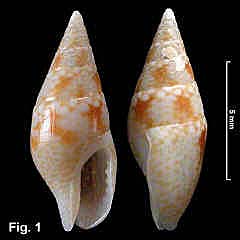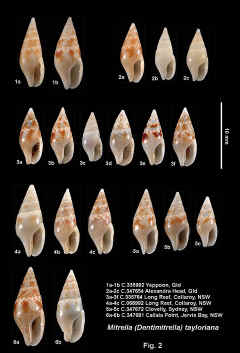|
|
|
|
|
Mitrella tayloriana (Reeve, 1859) Description: Shell moderately broad (for the genus), whorls slightly rounded, spire straight sided, aperture 40% of shell length. Protoconch of 2-2¼ smooth whorls. Spiral sculpture restricted to cords on base; axial sculpture absent. Outer lip sinuous in profile, with shallow sinus; lip much thickened externally; thickened internally, with 6-8 denticles decreasing in size from the second uppermost. Columella callus sharp-edged in mature shells; axial ridge along edge bearing about 5 small denticles. Siphonal canal very short. Colour fairly constant, apart from occasional white shells; on the body whorl, 1-3 rows of large white spots below the suture; below these, axial tan flames on upper half of whorl, sometimes coalescing to form a spiral band; below these, smaller white spots in quincunx on remainder of whorl. Interior white. Periostracum smooth. Size: Up to 12 mm in length, adults usually 9-10 mm. Distribution: Endemic to Australia; Alexandra Head, Queensland, southwards to Waratah Bay, Wilsons Promontory, Victoria. Also Bass Strait islands, but not Tasmania. One record from Yeppoon, Queensland, needs confirmation. Habitat: Intertidal on rocky shores, on algae and under stones. Very common. Comparison: This species has a fairly constant colour pattern, although the depth of colour varies from pale to dark brown. M. semiconvexa sometimes has a similar colour pattern, but is larger and broader. M. lincolnensis is similar in size, but is more slender with flat whorls, a different colour pattern and brown in the aperture. M. leucostoma is similar in size and shape and can only be distinguished by colour pattern. Synonymy: This was first described as Buccinum parvulum Dunker, 1847, but that name was preoccupied. Columbella albomaculata Angas, 1867 is a synonym. Remarks: This species is the most common of the genus in NSW, sometimes being abundant on intertidal algae. It seems to have an unusual restricted distribution, not reaching past Wilsons Promontory into southern Australia. Fig. 1: Clovelly, Sydney, NSW (C.347672) Fig. 2: Variation |

